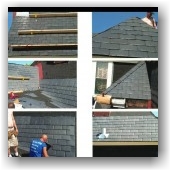Promoting ventilation on new roofs is important in maintaining and sustaining the life span of roofs. Adequate roof ventilation promotes a balanced temperature between the inside and outside temperatures. This balanced temperature will keep moisture away and reduces heat inside the house during the summer. Moisture will occur during cold seasons, which will decrease the life span of the woods.  Build up of molds will make the woods rot and cause it to collapse. In severe low temperatures, ice build-up will occur which further decreases the life spans of the woods. On the other hand, extreme temperatures will increase electricity bills due to air conditioning systems. These are just some of the risks when ventilation is not installed. Especially on houses located in areas, that suffer severe high and low temperatures, ventilation is very essential. A national building code is implemented to encourage homeowners to install ventilation system on new roofs. This will help homeowners decrease the cost of roofing repair and maintenance. To learn more about roofing ventilation, let us explore the different methods of ventilating systems. Moreover, how they work in removing hot air on new roofs.
Build up of molds will make the woods rot and cause it to collapse. In severe low temperatures, ice build-up will occur which further decreases the life spans of the woods. On the other hand, extreme temperatures will increase electricity bills due to air conditioning systems. These are just some of the risks when ventilation is not installed. Especially on houses located in areas, that suffer severe high and low temperatures, ventilation is very essential. A national building code is implemented to encourage homeowners to install ventilation system on new roofs. This will help homeowners decrease the cost of roofing repair and maintenance. To learn more about roofing ventilation, let us explore the different methods of ventilating systems. Moreover, how they work in removing hot air on new roofs.
How ventilation on new roofs work
Most ventilating systems attached on new roofs work dependently on the intensity of hot air inside the house. With the law of physics, hot air rises because it has lesser density than cold air. It works the same with a hot air balloon, which uses hot air to lift it up. Most ventilating systems are made from metal shaped into a dome with special designs that turns once hot air escapes. It continuously rotates to allow more hot air to escape constantly. There are no motor or any mechanical designs attached to roof ventilators. However, modern ventilation makes use of an exhaust fan to create a negative pressure in the house or attic that pulls outside air in and keeps air circulating inside the house or attic. Air-conditioning systems are also utilized to maintain good ventilation but it cost more energy compared to traditional ventilating methods.
Types of new roofs ventilation systems
Power vents – These types of ventilation system makes use of electricity to run a motor and move inside air out. Exhaust fans and air conditioning systems are examples of power vents. The downside when using this type of ventilation system is it produces noise during operation. In addition, it increases your electric bill dramatically.
Static ventilation systems – Are those found on rooftops that turn continuously. They work when hot hair rises and escapes through the vents. This type of vents is installed together with the roof during construction. It is lightweight and ideal for warehouses because it does work without the help of electricity.
Foundation vents – This maintains home ventilation with a coil that automatically closes and opens the vents depending on the temperature inside the house. The vents open when the inside temperature is rises. It closes when the inside temperature is lower than the outside. This is often installed at the corner of the house or place at the sides of new roofs.